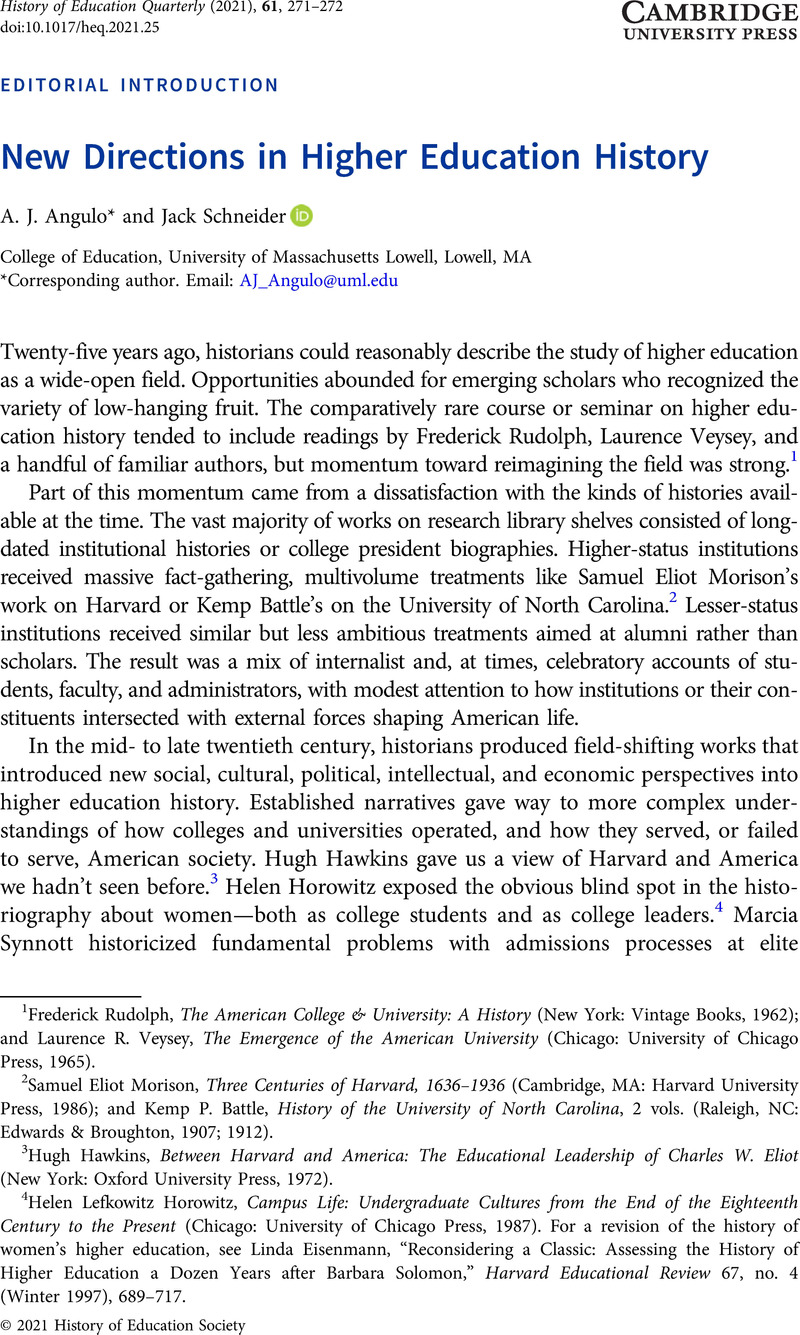Twenty-five years ago, historians could reasonably describe the study of higher education as a wide-open field. Opportunities abounded for emerging scholars who recognized the variety of low-hanging fruit. The comparatively rare course or seminar on higher education history tended to include readings by Frederick Rudolph, Laurence Veysey, and a handful of familiar authors, but momentum toward reimagining the field was strong.Footnote 1
Part of this momentum came from a dissatisfaction with the kinds of histories available at the time. The vast majority of works on research library shelves consisted of long-dated institutional histories or college president biographies. Higher-status institutions received massive fact-gathering, multivolume treatments like Samuel Eliot Morison's work on Harvard or Kemp Battle's on the University of North Carolina.Footnote 2 Lesser-status institutions received similar but less ambitious treatments aimed at alumni rather than scholars. The result was a mix of internalist and, at times, celebratory accounts of students, faculty, and administrators, with modest attention to how institutions or their constituents intersected with external forces shaping American life.
In the mid- to late twentieth century, historians produced field-shifting works that introduced new social, cultural, political, intellectual, and economic perspectives into higher education history. Established narratives gave way to more complex understandings of how colleges and universities operated, and how they served, or failed to serve, American society. Hugh Hawkins gave us a view of Harvard and America we hadn't seen before.Footnote 3 Helen Horowitz exposed the obvious blind spot in the historiography about women—both as college students and as college leaders.Footnote 4 Marcia Synnott historicized fundamental problems with admissions processes at elite institutions.Footnote 5 Steven Brint and Jerome Karabel reminded us about the understudied workhorse of American higher education: the community college.Footnote 6 And David Levering Lewis's magisterial work on W. E. B. Du Bois recontextualized the life of a key leader in African American higher education.Footnote 7 These and many other pathbreaking authors showed us all how much more there was left to do.
During the past quarter century, historians have accelerated the field's rate of maturity exponentially. The sheer volume of works on the college experiences of women, marginalized populations, and the disadvantaged alone has been transformative and generative. Equally animated publications on higher education and its relationship to research, teaching, science, democracy, religion, the economy, the legal system, and student movements have recast familiar lines of inquiry into wholly new avenues of research.Footnote 8 It's little wonder that one of the most popular and well-attended affinity groups in the History of Education Society (US) is on higher education.
With this special section, the History of Education Quarterly delves into yet another series of promising research questions about higher education that are grounded in history and that have implications for the present and future. What happened to the “free” college experiments in California and New York? Where did the distinction between in-state and out-of-state students come from? And how have town-gown relations been affected by off-campus housing? These questions, raised by the articles that follow, offer launching pads for further research. The answers presented establish a baseline for thinking through how these topics might apply to other historical settings, local contexts, and college populations. This issue's Policy Dialogue between historian David Labaree and sociologist Sara Goldrick-Rab further enhances this special section by establishing compelling points of connection with the articles. This was not by design but rather because the overlapping issues addressed are some of the most pressing in contemporary higher education. Collectively, the works in this special section highlight how far we have come over the past twenty-five years and yet how promising the field still is today.





